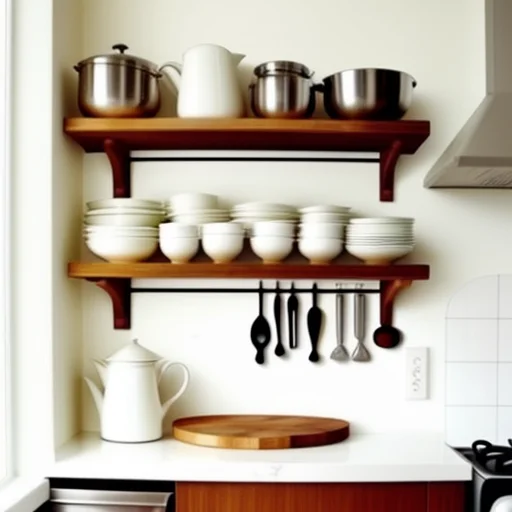As an Amazon Associate I earn from qualifying purchases.
Kitchen drawers cluttered with disorganized utensils, gadgets, and tools is a common headache in many homes. But lack of drawer space doesn’t mean you have to live with a messy kitchen. How to organize your kitchen utensils without drawers? With some clever solutions, you can organize your kitchen utensils without traditional drawers and enjoy an efficient, decluttered space.
Assess Your Current Kitchen Tools and Storage Space
The first step is taking a thorough inventory of everything you currently store in your kitchen.
- Remove all the utensils, gadgets, bakeware, and tools from the drawers and cabinets. Lay them out on the counter and get a visual of just how much you have accumulated over the years. Take your time and pull out every single item – it’s important not to miss anything in this initial purge.
- Be ruthless and honest with yourself – do you actually use everything on a regular basis? Or are there items you haven’t touched in years that can be donated or trashed? Sentimentality can make it tough, but keeping unnecessary tools will just lead to clutter.
- Pay attention to any duplicates you uncover. For example, six spatulas when you realistically only need two or three. Consolidate duplicates and get rid of excess.
- Take notes on which tools you use daily, weekly, monthly or just on special occasions. This info will come in handy later for placement.
- Measure the storage space you have available. Take into account shelves, cabinets, countertops, gaps between appliances, walls, etc. Understanding the dimensions you have to work with is key for choosing the right storage solutions.
- Consider dead space that can be transformed into storage like the back of cabinet doors or wasted narrow gaps between appliances. Get creative!
How to Organize Your Kitchen Utensils Without Drawers?
Choose an Organization System Based on Your Needs
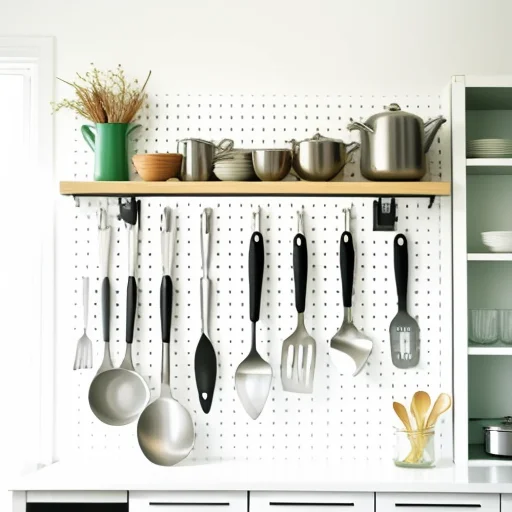
With your tools and space assessed, it’s time to decide which storage solutions will work best for your unique kitchen setup and cooking habits. Consider these popular solutions for how to organize your kitchen utensils without drawers:
Wall-Mounted Rails, Ledges, or Pegboard
Installing rails, ledges, or a pegboard provides plenty of hanging storage space for oft-used utensils. This clears up countertops and frees cabinet space for other items.
- Rails and ledges are great for holding kitchen tools like spatulas, tongs, whisks, silicone brushes, and ladles. Opt for versions with adjustable hooks to customize.
- Pegboard is extremely versatile – customize with hooks, baskets, and shelves of any size for ultimate organization. Arrange tools by frequency of use.
- Mount these storage solutions near cooking zones for easy access when preparing meals.
Pull-Out Cabinet Storage
Transform unused narrow spaces between or below appliances into clever pull-out cabinet storage. These make use of gaps that are otherwise wasted space.
- Mount pull-out cabinets on slides or casters for smooth access to stored items.
- Use them for baking sheets, cutting boards, trash can holders, or deep pots and pans. Having these items stashed right under appliances is both space-saving and convenient.
- Pull-out spice organizers are perfect for narrow gaps and eliminate the need for a cluttered spice drawer.
Magnetic Strips
Use magnetic strips inside cabinet doors or mount them on the wall to hold knives, spatulas, ladles, or any metal cooking tool securely. Get them as close to cooking zones as possible for easy access while cooking.
- Opt for finishes like stainless steel, copper, or brushed nickel to complement your kitchen aesthetic.
- Double up strips to accommodate more bulky items like pots and pans.
Rolling Carts
A rolling cart instantly provides extra storage space while retaining flexibility since it’s movable. Opt for a three-tiered design to maximize the vertical room.
- Use it as a portable kitchen island to keep essential tools and ingredients right at your fingertips when cooking or baking.
- Wheels allow you to roll it right up next to the cooking zone for easy access, then tuck it out of the way when not in use.
- Choose one with drawers, baskets, and shelves to organize items by category. Label clearly.
Organize Utensils Based on Usage and Frequency
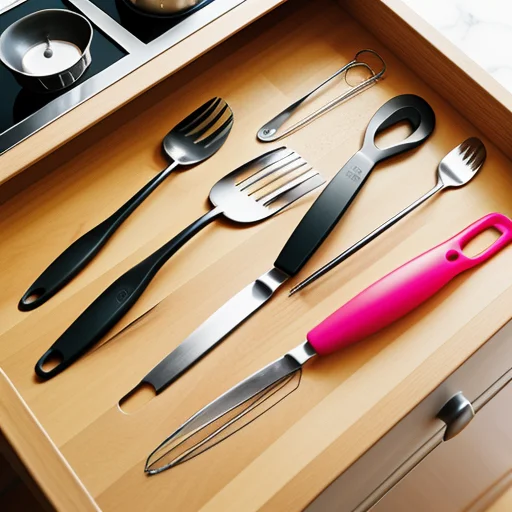
Once you’ve determined the optimal drawer-free storage furniture and solutions, it’s time to smartly group tools and utensils.
- Categorize cooking utensils, baking tools, serving utensils, food prep items, and gadgets into groups.
- Designate areas based on workflow – a baking zone, food prep zone, cooking zone, etc.
- Within each zone, keep your most frequently used tools in the most accessible spots. Reserve hard-to-access areas for rare or specialty items.
- Store utensils and tools used together in batches – like mixing bowls with matching spoons and whisks.
- Consider storing knife sets together on a magnetic strip for easy access.
- Group everyday drinking glasses and mugs together on an open shelf, wine glasses on a hanging stemware rack.
- Put all cooking oils/vinegars in one area, baking supplies together in another area.
Select Functional and Stylish Storage Containers
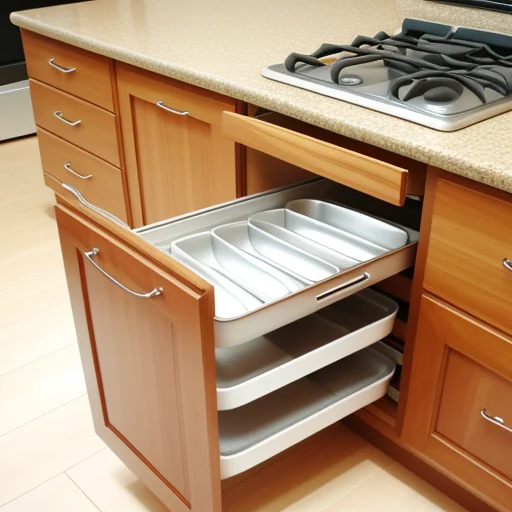
The right organizers keep items visible and within reach while adding aesthetic appeal. Consider materials like glass, plastic, ceramic, metal and mesh. Match lid styles to your utensils and tools. Label clearly.
- Opt for countertop crocks in finishes like bronze, marble, or limestone to hold most used tools like spatulas, tongs, and wooden spoons.
- Store gadgets in rotating trays or divided canisters to easily see and access what you need.
- Hang pots and pans from the walls with hooks, bars, and racks. Great for freeing cabinet space for other items. Choose finishes that match your decor.
- Repurpose wall-mounted magazine holders or wall-mounted paper towel holders for unused space. Great for cutting boards, bakeware, or lids.
- Use lid racks inside cabinet doors to organize awkward lids.
- Store dry goods like flour, sugar, rice in matching glass canisters on shelves or countertops. Use chalkboard labels for an earthy vibe.
Maintain the System Long Term
Getting organized is step one, but maintaining the system is just as crucial to long term success.
- Make a habit of putting items back in their designated spots after each use. Don’t let clutter overtake the space.
- When putting clean utensils away, take a second to return anything out of place to its assigned home.
- Designate one day each month to do a quick reorganization and purge any newly unused items before clutter accumulates.
- Every few months, re-assess the tools you actually use and donate or recycle anything that’s just taking up space.
- Be prepared to adjust the system as your cooking needs change. Add hooks, shelves, baskets or other accessories to expand storage.
- Deep clean storage containers and replace worn out labels seasonally to keep things looking fresh.
- Consider glass door cabinets to keep everything dust-free but visible.
Additional Tips for Small Kitchens
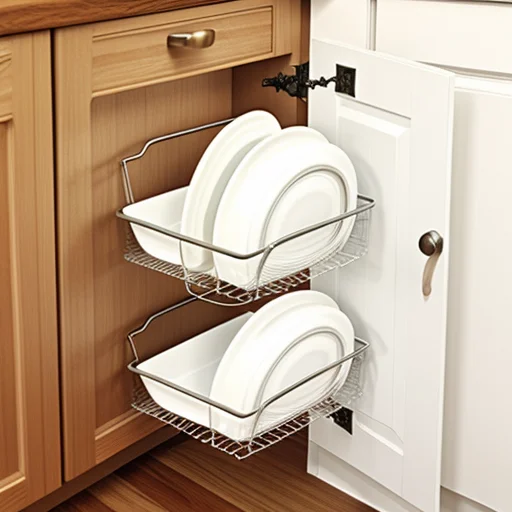
Limited room in a small kitchen can make organizing without drawers more challenging, but very doable with some adjustments.
- Take advantage of blind corner cabinets by installing lazy susans or vertical storage systems. Maximize the space.
- Use wall space creatively – build shelving all along the wall if possible rather than cramming things into base cabinets.
- When choosing storage furniture, opt for slender or narrow designs to conserve space.
- Attach an over-the-door hanger for pots and pans to utilize the back of doors.
- For especially small kitchens, consider storing some infrequently used appliances to free up room for everyday tools.
- Multipurpose carts with wheels and tiers are excellent for small kitchens since they can be moved around as needed.
- Make sure shelves and wall storage extends right to the ceiling vertically – wasted overhead space can be utilized.
- Use lighting under cabinets or shelves to eliminate shadowy, hard-to-see areas that lead to lost tools.
The lack of ample drawer space provides an obstacle in small kitchens, but with some creative solutions, you can find a home for all your essential tools and appliances. Focus on keeping the most-used items easily accessible and reserve hard-to-reach areas for occasional use products to maximize efficiency.
Alternative Storage Solutions to Consider
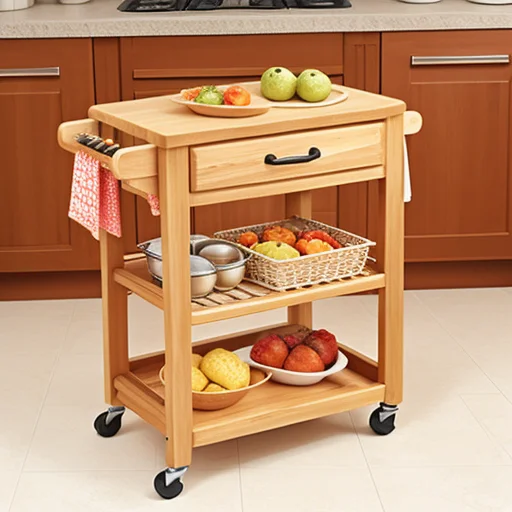
While the aforementioned options work in most kitchens, there are even more ways to organize utensils and tools without drawers if needed:
- Install open shelves instead of upper cabinets and use them to neatly display cooking tools in matching crocks, bins, or baskets. It creates a lighter, airier aesthetic perfect for small spaces.
- Mount a power strip with built in hooks directly on the wall or backsplash for hanging mugs, utensils, towels. Great use of space near an existing outlet.
- Attach a wall-mounted wooden rack with multiple compartments specifically designed to hold cooking utensils orderly and neatly.
- Use plastic shower caddies mounted horizontally on the wall or vertically inside cabinets to hold utensils. Affordable and adjustable.
- Install a wall-mounted wooden bar with hooks underneath to hang utensils and free up counter space.
With some creativity and willingness to deviate from traditional utensil drawers, you can discover storage solutions that maximize the utility of the unique space you have available. Try multiple approaches for an organizational system tailored to your needs.
Maintaining Long Term Success
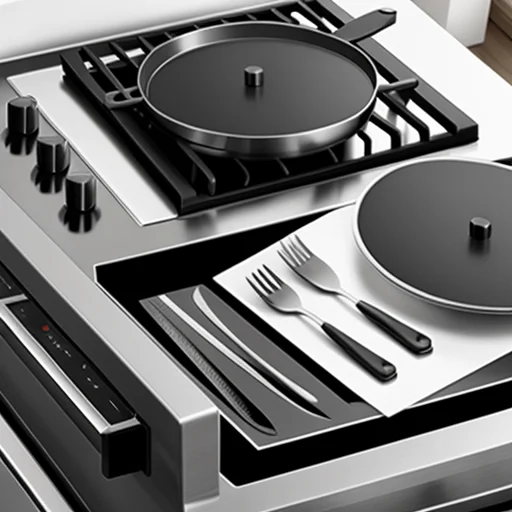
Putting time into creating a functional organizational system for your kitchen is an investment that can dramatically improve your cooking efficiency and enjoyment. But as many who have tackled kitchen organization know, setting it up is only half the battle – maintaining the system long term is key for success. Here are some pro tips to make it stick:
- Purge before organizing – Address the root cause of clutter by getting rid of excess BEFORE putting everything away neatly. Only keep kitchen tools you know you use and love.
- Map it out – Having a plan for where items will go before you start helps immensely versus randomly trying to “fit stuff” onto shelves. Measure and optimize storage areas ahead of time.
- Assign homes for everything – The secret to long term organization is ensuring every single item, no matter how small, has a designated spot to live when not in use.
- Map frequently used items conveniently – Where you place items directly affects usage habits. Position everyday tools exactly where you naturally reach for them to cook.
- Try to group logical categories – Keep baking supplies together, spices organized by cuisine, drinking glasses near the kitchen sink – think about natural pairings.
- Label meticulously – Use tags, chalkboard labels, and containers with visibility to remind family members where things belong. Don’t make them guess.
- Regular maintenance – Set reminders to tidy, declutter, and maintain the system monthly.Don’t wait until things are unruly.
- Adjust over time – As your needs change, be willing to move items around, add new solutions, remove unused tools to adapt.
Keeping kitchens clutter-free is an ongoing effort, but incredibly worthwhile for stress-free cooking and baking every day. Just remember that maintaining organization is a process, not a one-time project.
Recommended Storage Solutions to Purchase
While many organizational tools can be fashioned from household items, investing in purpose-built storage solutions can optimize kitchen space even further. Here are some of the top-rated and recommended products:
- Copco Basics 15-Inch Pan Organizer – adjustable chrome shelves perfect for nesting pans and lids while maximizing cabinet space.
- OXO Good Grips Utensil Organizer – customizable compartments keep utensils neatly separated and is expandable.
- Simplehouseware Under Sink 2 Tier Sliding Cabinet Basket Organizer – sliding baskets make items in back of cabinet accessible.
- Copco Pantry Cabinet Lazy Susan – great for corner cabinet organization and smoothly gliding access.
- Lynk Professional Wall Mounted Knife Bar – safely store cutlery along the wall and clear up drawer space.
Investing in quality storage solutions pays dividends by extending the life of your organizational system and even saving you money over time once purchased. They also simply look neater and uniform than DIY options.
Final Thoughts on Organizing Without Drawers
At first glance, organizing a kitchen without the benefit of ample drawer space may seem daunting. But with some planning, effort, and creative solutions, you can craft an efficient organizational system customized to your cooking needs, kitchen layout, and lifestyle.
The key is thoroughly assessing all your tools, carefully measuring the unique storage areas available, and selecting storage furniture that optimizes the space. Take the time to group tools logically by cooking zone and frequency of use.
Maintaining the system is just as important as the initial organizing process. Stay on top of putting items back after use and regularly purge unused items before they accumulate.
With an organized kitchen, you’ll be able to spend more time enjoying cooking and less time searching for a missing tool. No more jumbled drawers – just a place for everything and an efficient workflow. Get started on your own organizational journey and transform the feel of your kitchen today!
As an Amazon Associate I earn from qualifying purchases.

